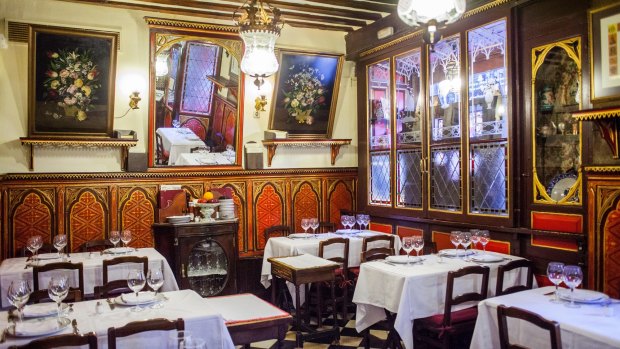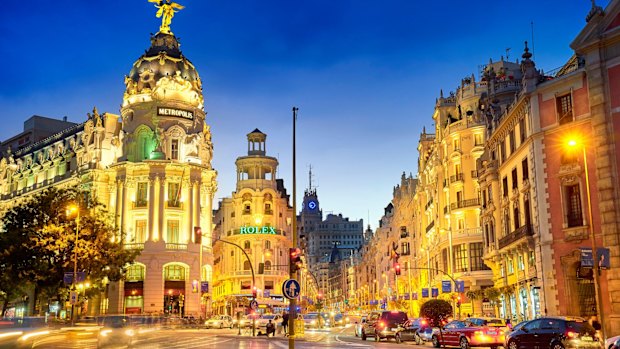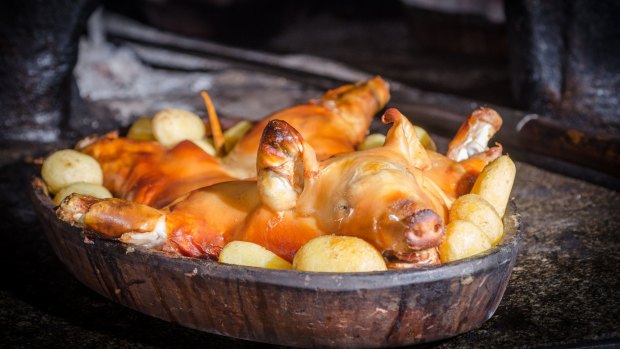This was published 6 years ago
Where to find the best tapas in Madrid, Spain and how to enjoy it
By Sue Williams

Madrid's Sobrino de Botin, est. 1725, the oldest continually operating restaurant in the world.Credit: Alamy
To some, Spanish tapas is an interesting way to eat a series of small savoury dishes, either as appetisers or as dinner. To others, it's more a way of life.
"It's about good food, ambience and human connections," says David Gillison, an Australian living in Madrid, who runs tapas tours for visitors. "Tapas is an integral part of Spanish culture. It's about taking some downtime and catching up with friends over some delicious food and wine.
"It's an attitude, it's a way of living your life and, most importantly, it's a way everyone can share in the lifestyle of Spain …"

Gran Via in Madrid, where tapas is more than a dish, it's a way of life.Credit: Alamy
A bold boast for what's essentially a few little plates of food sometimes eaten so casually, it's done standing up? Maybe. But Gillison's enthusiasm is infectious. He fell in love with Spain five years ago, left his native Cairns to see what it would be like to live there, and hasn't looked back since.
Now his mission in life is to spread the Spanish zest for life via its passion for tapas and, so far, he's finding an appreciative audience.
The first stop of his company Madridivine's tapas tour is a small neighbourhood tapas shop and bar, with scrubbed wooden tables and chairs where the patron greets each customer individually with a warm handshake. It's in Huertas, also known as Barrio de las Letras, a neighbourhood where some of Spain's best-known literary figures, including Don Quixote, author Miguel de Cervantes and playwright and poet Lope de Vega, once lived.

Sobrino de Botín's specialty dish, roast suckling pig.Credit: Alamy
Here, the speciality dish is boquerones – fresh anchovies served with country green olives, mild chillies and home-made crisps – washed down with generous quantities of the local northern Spanish vermouth. The food is a delicate balancing act: putting a curled anchovy on a crisp and then scattering it with olives and a hearty bite of chilli.
The drink is an even more tricky test. At first taste, it's a little like cough medicine. At second, it's much more hearty and warming. At the third and final sip, it deals a real punch.
"This is a wonderful place to visit as soon as you've flown into Madrid," says Gillison. "The vermouth here is the perfect jetlag cure. A few glasses of this, and you won't even remember you've only just arrived!"
After a few platefuls of the boquerones, it's time to move on, however. Taking tapas is not for the faint-hearted, it seems. It's a vigorous activity that involves dipping into various small bars, grazing from the best of their menus, then moving smartly on. "You have to be light on your feet," Gillison says. "Otherwise the experience can become stagnant … "
The origins of tapas are obscure. Some say it started with a Spanish king who had his sherry protected by a "tapa" or "lid" to keep out flies or dust. Others say it started with Spanish troops who were served small plates of food to slow down the effects of alcohol.
Today, in some of the best spots, tapas will be served unbidden, to match the drink you've ordered. Others will pour drinks according to the food you've asked for. Some will be in the form of "pinchos", or tiny plates of delicacies spiked with toothpicks, while others will be served as larger plates or "raciones".
Our next stop is nearby and most of the food – sardines, plump tomatoes and cheese – is served on bread. You often don't get a choice. The barman takes one look at you and the drink you've ordered, and then serves up what he thinks you'll enjoy best. It's an interesting experiment.
After eating our fill, we head out and wander the bars behind hand-carved wooden doors and wrought-iron balconies offering wine and cheese tastings for workers on their way home. The oldest continually operating restaurant in the world, Sobrino de Botín is not far away. It was founded in 1725, was a favourite haunt for Ernest Hemingway and its specialty is roasted suckling pigs splayed out on huge earthenware plates. .
Our next stop is a highlight: a tiny place that has been serving food and drink since 1906. The speciality here is prawns sizzling in small earthenware pots with oil, chilli and garlic, prepared by a man who has been doing it for 40 years. Diners stand around pots balanced on tall tables and tear pieces off hot, crusty, fresh bread, and dip them into the prawns.
Apparently, about 200 kilograms of prawns are served here most days. Madrid is second only to Tokyo when it comes to the world's biggest fish markets.
We have a quick look, then head into the Museo de Jamon, a chain of stores celebrating all things ham, with dozens hanging from the ceiling. Our final stop is known for its great food, wonderful photographs on the wall and outstanding jazz. Here we have the speciality croquettes, some of ham and others of seafood and red peppers.
These are slipped down with cava, the clean, dry local champagne, which works as a great palate-cleanser between courses.
"Tapas is about generosity," says Gillison. "People always love to come back to these places and they make such good friends here."
FIVE THINGS EVERYONE SHOULD KNOW ABOUT TAPAS
1. Order a drink first and receive a free tapa. After that, it's best not to order too many things all at once. Leave room to order more when you see something delicious arrive for someone else.
2. Travel with your tapas. Find out what the speciality dish is in each place, order that, enjoy, then move on to the next tapas place for its best offering. It's a great way to incorporate exercise into your dining experience, too.
3. Chatting over shared plates of tapas is a quick and easy way to keep up with mates.
4. Be friendly but assertive. Spanish bars can get busy and waiting quietly to get served might involve a lengthy wait. And if you have a good experience, don't forget to tip, usually 10 per cent of the total bill.
5. Life in Madrid, says David Gillison, is lived on the streets, so keep an eye open for places attracting groups of locals. It may be a new tapas place offering something different, or an old favourite rediscovered. Keep your plans flexible so you don't miss out.
Sue Williams travelled as a guest of Bunnik Tours.
TRIP NOTES
MORE
Visit Madrid, see esmadrid.com/en
Madridivine offers private tapas and walking tours in Madrid. See madridivine.com
FLY
Qantas and Emirates fly to Madrid via Dubai. British Airways and Cathay Pacific fly via Singapore or Bangkok.
STAY
Hotel Preciados is right in the city centre, near lively Plaza Santo Domingo. Standard double rooms cost about $140 a night. See preciadoshotel.com
TOUR
Bunnik Tours is an Australia-based small-group tour specialist. Its small-group 26-day tour of Spain, Portugal and Morocco visits a number of Spanish highlights – most with wonderful tapas – including Madrid, Barcelona, Seville, Valencia, Granada, Alicante and Murcia. Prices start from $10,595 per person, including flights from Australia. Phone 1800 286 645. See bunniktours.com.au
Sign up for the Traveller Deals newsletter
Get exclusive travel deals delivered straight to your inbox. Sign up now.